The Daily Observer London Desk: Reporter- John Furner
A deadly bacteria that kills up to 50 percent of people it infects was recently detected at the Mayo Clinic in Arizona.
Three laboratory workers were exposed to the Burkholderia pseudomallei bacteria while testing samples from a 58-year-old man who had come in with an artery infection.
The employees were swabbed for the bacteria at the Phoenix hospital for three weeks to ensure they had not become infected. All three tested negative on every test.
The bacteria is native to Australia and parts of South East Asia but has made waves in the US after the Centers for Disease Control and Prevention (CDC) warned it was now endemic to the Gulf Coast.
Lab staff were exposed to the bacteria at the Mayo Clinic center in Phoenix, Arizona (pictured)
In the case report, one employee — with an underlying condition that was not detailed — was described as being at ‘high risk’ of infection.
The individual grabbed samples of the bacteria from a petri dish and placed them into a machine for testing.
It was unclear how they were picked up, but this was likely done using an object like a pipette. They were likely also wearing protective equipment.
The individual had also tested the bacteria on an open worktop outside of the biological safety cabinet, which can prevent the organisms from spreading.
The other two staff members were considered to be at ‘low risk’ of catching the disease.
They had both been repeatedly inspecting petri dishes where the bacteria were growing but were not reported to have picked up the bacteria, which would have brought them into closer contact.
All the potentially infected employees had to check their temperature twice a day for three weeks. They were also asked to report any symptoms.
Two of the three also agreed to serological monitoring for six weeks, where blood samples are collected and tested for antibodies against the bacteria.
At every test, the employees showed no signs of disease. The blood tests also did not reveal any antibodies against the bacteria.
The exposures occurred in mid-January 2021, but have only just been revealed in the journal Emerging Infectious Diseases.
A total of 30 potential contacts were identified.
The staff was accidentally exposed to the bacteria because it was initially believed that the samples did not contain the potentially deadly organism.
It was unclear what happened to the patient diagnosed with a mycotic aneurysm or an artery infection.
Dr Lisa Speiser, an infectious disease physician at the clinic, and others who contributed to the report said: ‘Lack of clinical and laboratory suspicion for Burkholderia pseudomallei (B. pseudomallei) resulted in incidental laboratory exposure of three employees.
‘US laboratories should remain vigilant for and aware of the growth characteristics associated with B. pseudomallei to help avoid occupational exposure.’
Lab exposure to the bacteria is extremely rare in the United States because infections are not commonly reported. Only two cases have been recorded in US medical literature, with the last being in 1981.
Estimates suggest that about 12 Americans are diagnosed with the infection every year, although these are almost always linked to travel.
The patients are diagnosed with melioidosis, a disease resembling tuberculosis or pneumonia.

The above map shows countries where the bacteria has been detected and the states in the US where the CDC says it is now endemic
B. pseudomallei is often found lurking in soil and fresh- or brackish waterways.
Humans can become infected after coming into contact with a contaminated area and then ingesting the bacteria.
It is also possible for an infection to occur via inhaling dust or water droplets that are contaminated.
In most cases, the bacteria do not trigger symptoms because the immune system can can fight it off.
But when an infection begins, patients may suffer from symptoms including joint pain, fever and headaches in the early stages.
This can then progress to melioidosis, with the CDC warning that between 10 and 50 percent of cases are fatal.
Individuals who live along the Gulf coast and have conditions such as diabetes, kidney disease and chronic lung disease are particularly at risk.



